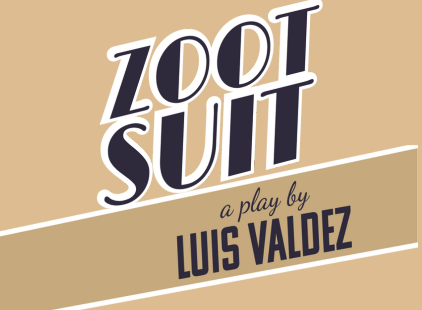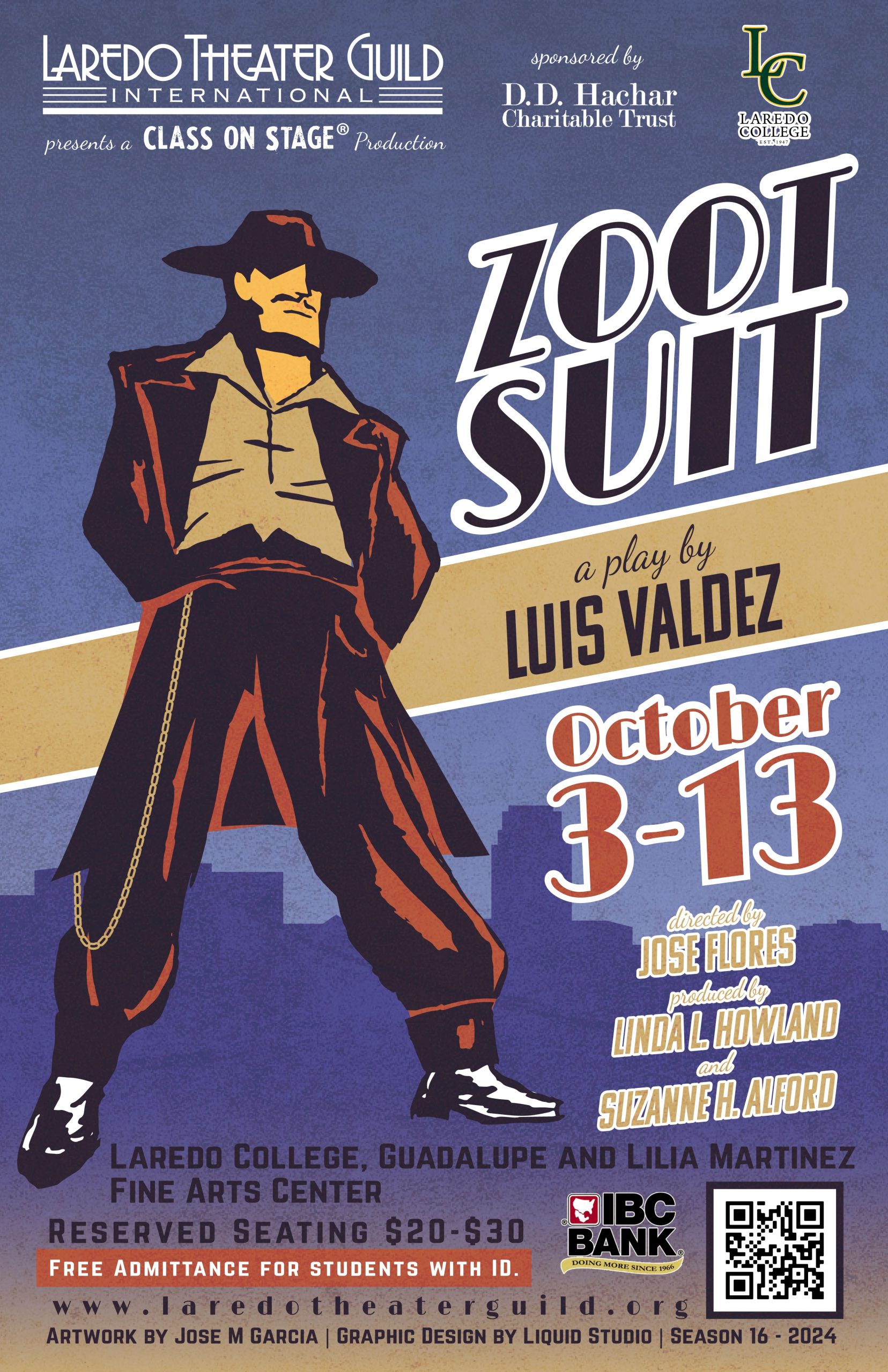Zoot Suit
by Laredo Theatre Guild International
Oct. 03 - Oct. 13, 2024
Thursdays-Sundays
 Luis Valdez’s revolutionary play Zoot Suit is rooted in the historical events of the Sleepy Lagoon Murder of 1942 and the Zoot Suit Riots of 1943 in Los Angeles, California. The play tells the gripping story of Henry Reyna and the 38th Street Gang, who were unjustly tried and convicted for the alleged murder of José Gallardo Díaz despite a lack of concrete evidence. This miscarriage of justice saw twenty-one members of the gang become victims of racial profiling and police violence, leading to life sentences.
Luis Valdez’s revolutionary play Zoot Suit is rooted in the historical events of the Sleepy Lagoon Murder of 1942 and the Zoot Suit Riots of 1943 in Los Angeles, California. The play tells the gripping story of Henry Reyna and the 38th Street Gang, who were unjustly tried and convicted for the alleged murder of José Gallardo Díaz despite a lack of concrete evidence. This miscarriage of justice saw twenty-one members of the gang become victims of racial profiling and police violence, leading to life sentences.
The sensational coverage of the Sleepy Lagoon trial fueled racial tensions in Los Angeles, culminating in the infamous Zoot Suit Riots. Over 600 Latino youths were arrested during these riots, sparked by attacks from US servicemen and white Angelenos on individuals wearing zoot suits. These suits were symbolically associated with anti-Americanism due to the generous amount of fabric used to make them during the wartime rationing period in American History.
However, the zoot suit became a powerful symbol of cultural pride and resistance for Los Angeles’ Chicano community. The defiance exhibited by those who wore zoot suits marked the beginnings of the Chicano Movement, or El Movimiento, a pivotal moment in the fight for civil rights and social justice.
This play continues to resonate and inspire new generations in the fight for equality and cultural recognition.
The Significance of the Zoot Suit of the 1940s
Following Japan’s bombing of Pearl Harbor, the United States officially entered World War II on December 8, 1941.
Brave men dutifully joined the US Armed Forces and swapped their civilian clothes for a military uniform. As so much wool was needed to manufacture these uniforms (as well as silk for making parachutes and maps), civilian resources were put under immense strain.
To cope with this, in March 1942, the US War Production Board issued regulation L-85, which put strict limitations on clothing and the use of natural fibers. As part of these regulations, a new style of 1940s men’s suit emerged – thus, the Victory suit was born.
The 1940s men’s Victory suit was mixed with synthetic fibers such as rayon (derived from wood pulp) to reduce the amount of natural material used. The jacket was shorter, and pants often were narrower with no pleats or cuffs; this suit has no excess fabric or embellishments of any kind. There was even a strict limit on zippers or buttons, which weren’t used unless absolutely necessary.
Wearing the Victory suit allowed men to feel that they were being patriotic and helping the troops by giving up limited and much-needed resources.
In stark contrast to the Victory Suit, there was an outlandish 1940s men’s suit that was the complete antithesis of the war-produced suits as instructed by the war production board. This was the infamous Zoot Suit. The Zoot suit had very loud color options in sharp contrast to the slimmed-down Victory suit.
The jacket was oversized with wide lapels and shoulder pads, while the pants were extra high-waisted and wide-legged, dramatically narrowing at the ankle. Symbolizing cultural pride, the Zoot suit was soon adopted by young Mexican and Italian-American men.
During World War II, the Zoot Suit was widely viewed as a deeply illicit item of clothing due to the over-abundance of materials used. It was often linked to delinquency and criminal behavior by the media and law enforcement, reflecting the era’s racial prejudices and xenophobia.
The restrictions as set out by the war board banned the making of the wide-cut and over-the-top Zoot suit; wearers of the Zoot suit were thought of as unpatriotic. Most honest and rule-abiding tailors followed the restrictions, but a handful of bootleg tailors in New York and Los Angeles continued to make them.
Luis Valdez’s production of Zoot Suit is a landmark Chicano play that explores cultural identity and systemic racism through the lens of the Zoot Suit Riots and Sleepy Lagoon Trial. It portrays the struggles of the Chicano community in 1940s Los Angeles, California, highlighting themes of racial profiling, media influence, and the fight for civil rights. The play’s enduring influence reflects ongoing discussions about race and justice.
Directed by Jose Flores; produced by Linda L. Howland and Suzy Alford.
Get ready to be captivated by the incredible talent that will bring this powerful story to life:
HENRY Benjamin Lule
EL PACHUCO- Jason Angco-Barrera
ENRIQUE- Luis Pedro Garcia
DOLORES- Stephanie Solis Schynder
LUPE- Savannah Vela RUDY- Jorge Monreal
GEORGE SHEARER-Ben Hinojosa
ALICE BLOOMFIELD- Allyson Tellez
DELLA BARRIOS- Lorraine Zapata
SMILEY- Reynaldo Tijerina
JOEY- Adan Villareal
TOMMY- Orlando Joel Valdez Romero
ELENA- Gaby Mangual
RAFAS / MARINE- Jesus Mendoza
RAGMAN/ SAILOR- Genaro Reyna
GUERA/ Ensemble- Silvia Reyes
HOBA/ Ensemble-Anais Perez
LIEUTENANT EDWARDS / JUDGE / GUARD- John Kilburn
PRESS- John Maxstadt
CUB REPORTER- Brianna Garcia
PACHUCA TRIO- Gaby Mangual, Lisa Martinez, Bianca Cubriel
You won't want to miss this!
Zoot Suit
by Luis Valdez
Laredo Theatre Guild International
October 03 - October 13, 2024
October 3rd - 13th, 2024
at Laredo College, Guadalupe and Lilia Martinez Fine Arts Theatre
Tickets $20, $25, and $30; available free to students. Select seats and purchase online HERE.
